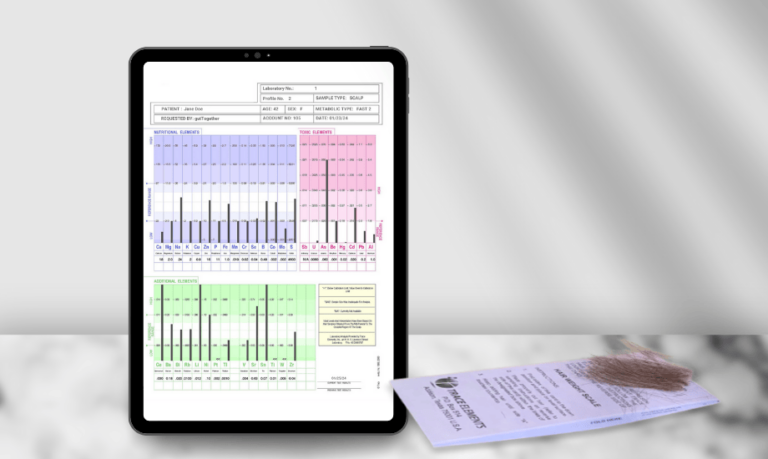Hair Tissue Mineral Analysis (HTMA) is a diagnostic tool that measures the mineral content of a small hair sample. This test provides insights into the levels of various essential minerals and toxic heavy metals that have accumulated in the body over time. Unlike other tests that rely on blood or urine samples, HTMA analyzes the minerals that are deposited in the hair as it grows, offering a longer-term view of mineral status and imbalances.
How does HTMA work?
Hair grows slowly, at a rate of about half an inch per month, and during this time, it absorbs and stores minerals and toxins from the body. A sample of hair, typically taken from the back of the scalp, represents a record of the body’s mineral status over the past 2-3 months. The hair sample is sent to a specialized lab, where it is analyzed for levels of key minerals like calcium, magnesium, sodium, potassium, zinc, copper, and more, as well as toxic elements like lead, mercury, and aluminum.
Why is mineral balance important?
Minerals play a crucial role in many bodily functions. They act as cofactors for enzymes, are essential for nerve transmission, muscle contraction, and maintaining the body’s pH balance. An imbalance in even a single mineral can impact metabolic functions, energy production, hormonal regulation, and overall health. HTMA can reveal these imbalances and help pinpoint what adjustments might be needed in diet, lifestyle, or supplementation to restore balance.
HTMA as a window into metabolic function
The results from HTMA don’t just show individual mineral levels—they also reveal the ratios between certain minerals, which can indicate how different systems in the body are functioning. For example, the ratio of calcium to magnesium can reflect the balance between sympathetic (fight or flight) and parasympathetic (rest and digest) nervous system activity. The sodium-to-potassium ratio can indicate adrenal function and stress levels.
This makes HTMA not just a test of mineral levels but also a tool that provides a snapshot of metabolic trends and how the body is adapting to various stresses. It allows practitioners to see underlying patterns and tendencies that might not be apparent from traditional blood tests, making it a valuable tool in functional and integrative medicine. Often the HTMA can predict patterns in the hair months or even years before they appear in the blood making it a great preventative health test.
How is HTMA Different from Blood Work?
Hair Tissue Mineral Analysis (HTMA) differs significantly from blood work in terms of what it measures and the type of information it provides about the body’s mineral status. While both can be valuable for assessing health, they serve different purposes and can complement each other effectively when used together. Here’s how they differ:
Short-Term vs. Long-Term View
Blood tests provide a snapshot of what’s happening in the body at a specific moment. This is because the body tightly regulates mineral levels in the blood to maintain balance and ensure critical functions, like heart rate and nerve function, remain stable. For example, if your body is low in calcium, it might pull calcium from bones to maintain blood levels, which means a blood test could show normal calcium levels while a deeper deficiency is present.
HTMA, on the other hand, measures the minerals that have been deposited in the hair over several months. This provides a long-term view of how minerals are being stored and used in the body, making it possible to identify chronic patterns and trends. It can highlight deficiencies or excesses that might not show up in blood work but are affecting overall health.
Revealing Hidden Causes Behind Blood Work Results
HTMA can be particularly useful when used alongside blood tests to gain a deeper understanding of the root causes behind abnormal results. For instance:
- Iron Levels: Blood tests may reveal low iron or ferritin (the protein that stores iron in the body), suggesting an iron deficiency. While the blood test shows the deficiency, it may not explain why it’s occurring. HTMA can help by revealing other mineral imbalances that might be impacting iron absorption and utilization. For example, high calcium levels or low copper levels seen in an HTMA report can interfere with the body’s ability to properly use iron, offering clues to improve iron levels without solely relying on supplements.
- Thyroid Function: Blood work may indicate low thyroid hormone levels, suggesting hypothyroidism. While blood tests measure thyroid hormone levels directly, HTMA can offer insights into mineral imbalances that may be contributing to thyroid dysfunction. For example, low levels of potassium in HTMA can be a factor in sluggish thyroid function, as potassium is essential for transporting thyroid hormones into cells. By addressing the underlying mineral imbalance, it may support more effective thyroid function and improve overall metabolism.
HTMA as a Stand-Alone Tool
In some cases, HTMA can be used on its own to address mineral imbalances, especially for clients who prefer a non-invasive approach or are looking to target chronic issues. Because HTMA reveals not just individual mineral levels but also the ratios between key minerals, it provides a comprehensive view of the body’s metabolic state. This can be particularly useful for identifying stress patterns, adrenal health, and how well the body is managing overall mineral balance.
For example, a high sodium-to-potassium ratio might indicate chronic stress or adrenal fatigue, while low magnesium levels could be contributing to muscle cramps or poor sleep. By using HTMA as a stand-alone tool, practitioners can create targeted protocols to address these imbalances directly through diet, lifestyle changes, and targeted supplementation.
Combining HTMA and Blood Work for a Holistic View
When used together, HTMA and blood work can provide a full picture of a person’s health. Blood work excels at diagnosing acute conditions and assessing immediate nutrient levels, while HTMA helps reveal the deeper, chronic patterns and underlying mineral status that could be influencing those conditions. This combination allows for a more individualized and effective approach to improving health.
Why Would Someone Do HTMA vs. Blood Work?
While blood work is a standard method for diagnosing health conditions and assessing nutrient levels, HTMA offers unique insights that can make it a valuable alternative or complementary tool. Here are a few scenarios where HTMA can provide a deeper understanding of underlying health issues, especially when blood work may fall short:
-
Thyroid Function
Blood tests are typically used to measure thyroid hormone levels such as TSH, T3, and T4, providing a direct view of thyroid activity. However, they don’t always reveal the mineral imbalances that could be contributing to poor thyroid function. For example, an HTMA might reveal low levels of potassium, which is critical for helping thyroid hormones enter cells and be properly utilized by the body. Without sufficient potassium, even if blood work shows “normal” thyroid hormone levels, the person may still experience symptoms like fatigue, weight gain, or cold intolerance because the hormones aren’t reaching their target cells effectively.
-
Low Iron Levels
Iron deficiency is often diagnosed through blood work by looking at ferritin and hemoglobin levels. However, HTMA can provide insights into why iron might be low in the first place. For instance, it might reveal a high calcium level that is blocking iron absorption or a low copper level, which is essential for proper iron metabolism. By addressing these underlying imbalances, it’s possible to improve iron levels more sustainably without simply increasing iron supplements, which can sometimes cause digestive discomfort.
-
When Blood Work is “Normal,” but Symptoms Persist
One of the most common scenarios where HTMA shines is when a client’s blood work comes back “normal,” yet they still don’t feel well. They might experience symptoms like low energy, digestive issues, poor sleep, or brain fog, despite their lab results indicating that everything is within standard ranges. In such cases, HTMA can uncover hidden patterns that blood work misses.
For example, HTMA might reveal a calcium-to-magnesium ratio that suggests high levels of stress, even if blood levels of these minerals appear normal. Or it could show a low sodium-to-potassium ratio, indicating adrenal fatigue, which might not be apparent from blood tests alone. These patterns help identify why someone might feel burnt out or anxious even when their blood work doesn’t provide clear answers.
HTMA as a Guide to Personalized Solutions
Whether someone is dealing with chronic fatigue, hormonal imbalances, or lingering symptoms despite normal blood results, HTMA can help connect the dots and guide a more individualized approach to healing.
HTMA Mineral Ratios That Provide Insight
Hair Tissue Mineral Analysis (HTMA) offers unique insights through various mineral levels and ratios that reveal deeper patterns in the body’s functioning. These ratios provide a window into how well different systems are operating, from metabolic rate to adrenal function, and can pinpoint underlying causes of chronic symptoms. Here’s a closer look at some of the key HTMA ratios and how they can shed light on common health concerns such as hair loss, fatigue, moodiness, infections, and heavy metal or toxic burden:
-
Hair Loss
- Calcium-to-Potassium Ratio (Thyroid Ratio): This ratio provides insights into thyroid function, which plays a critical role in hair growth. A high calcium-to-potassium ratio indicates a sluggish thyroid, which can contribute to thinning hair or slow hair growth. Low thyroid activity means a slower metabolic rate, which can affect the health of hair follicles.
- Sodium-to-Potassium Ratio (Adrenal Ratio): This ratio reflects the balance between sodium and potassium, two minerals that are important for adrenal function. An imbalanced sodium-to-potassium ratio, particularly if sodium is too high, may indicate stress on the adrenal glands, which can also impact thyroid health and hair growth.
-
Fatigue
- Sodium-to-Magnesium Ratio (Adrenal Function): This ratio is crucial for understanding the state of the adrenal glands. A high sodium-to-magnesium ratio may indicate a state of acute stress or adrenal overactivity, while a low ratio suggests adrenal exhaustion or chronic fatigue. When the adrenal glands are overworked, they can no longer produce sufficient stress hormones, leading to persistent fatigue.
- Calcium-to-Magnesium Ratio (Blood Sugar Balance): This ratio gives insights into blood sugar regulation and metabolic rate. Imbalances here can affect energy levels because stable blood sugar is essential for sustained energy throughout the day. A high ratio can indicate blood sugar imbalances that may contribute to fatigue and difficulty maintaining energy.
-
Moodiness
- Calcium-to-Potassium Ratio (Thyroid Function): Since thyroid function can greatly influence mood, imbalances in this ratio can contribute to mood swings, irritability, or feelings of depression. Low thyroid function often results in slower neurotransmitter production, affecting mood stability.
- Sodium-to-Potassium Ratio (Emotional Balance): This ratio is also known as the “life-death ratio” due to its importance in maintaining nervous system stability and emotional resilience. Imbalances can manifest as anxiety, irritability, or moodiness, with a low ratio often indicating a chronic state of stress or burnout, and a high ratio pointing to a more reactive state.
-
Infections
- Sodium-to-Potassium Ratio (Immune System Activity): The sodium-to-potassium ratio is also an indicator of immune system function. A very low ratio can suggest suppressed immune activity, making the body more vulnerable to chronic infections. Conversely, a high ratio may indicate an overactive immune response, which could occur during acute infections or inflammation.
- Copper Levels and Copper-to-Zinc Ratio (Immune Modulation): Copper is essential for immune function and the body’s ability to fight off infections. HTMA can reveal low copper levels or an imbalanced copper-to-zinc ratio, which might indicate a compromised immune response. Zinc is equally important for immune function, and an imbalance in this ratio can contribute to susceptibility to infections.
-
Heavy Metals/Toxic Burden
- Lead, Mercury, Aluminum, and Other Toxic Elements: HTMA can directly measure the levels of toxic heavy metals like lead, mercury, aluminum, arsenic, and cadmium in the hair. These toxic elements can accumulate in the body over time, disrupting enzyme function, mitochondrial activity, and overall cellular health. Even small amounts can contribute to fatigue, brain fog, and other chronic symptoms.
- Calcium Levels as a Detox Marker: High levels of calcium in HTMA can indicate that the body is attempting to “wall off” toxic metals in bones and tissues to prevent them from circulating. This defensive response can help protect the body in the short term, but over time it can indicate a higher toxic burden and the need for detoxification support.
HTMA is preventative
HTMA serves as a powerful preventative tool by identifying mineral imbalances and toxic heavy metal exposure before they manifest as more serious health conditions. Because it provides a long-term view of the body’s mineral status, HTMA can highlight trends that indicate potential issues, such as adrenal fatigue, thyroid imbalances, or compromised immune function, allowing for early intervention. By addressing these imbalances proactively, HTMA can help prevent the progression of symptoms and support overall well-being, making it an excellent tool for those seeking to optimize their health and avoid future complications.
The Science and Validity Behind HTMA
The accuracy and validity of HTMA testing often come down to the methodologies used by the laboratory performing the analysis. One of the key factors in reliable HTMA results is how the hair samples are prepared and processed before analysis. Trace Elements, Inc., a well-established laboratory specializing in HTMA, emphasizes the importance of using unwashed hair samples to ensure accurate mineral readings.
Why Unwashed Hair Samples Matter
Some HTMA labs use chemical washing processes on hair samples before testing. While this can remove external contaminants like shampoos or environmental pollutants, it also risks altering the natural mineral content of the hair. Chemical washing can strip away minerals such as sodium, potassium, and other water-soluble elements, leading to potentially inaccurate or skewed results.
Trace Elements, Inc. avoids chemical washing to maintain the integrity of the sample. By testing hair in its natural state, they can provide a more accurate representation of the minerals that are actively being stored and excreted by the body over time. This method allows for a true reflection of long-term mineral status and metabolic trends, making the data more reliable and effective for practitioners and clients alike.
Scientific Accuracy and Quality Control
Trace Elements, Inc. follows strict protocols for sample handling, preparation, and analysis, using state-of-the-art equipment to ensure precision. Their approach includes using sophisticated mass spectrometry to measure mineral levels and ratios, which contributes to their reputation for delivering consistent and scientifically sound results.
By avoiding the washing of hair samples and adhering to high standards in testing procedures, Trace Elements, Inc. ensures that their HTMA results provide a precise snapshot of a client’s mineral and heavy metal status. This commitment to accuracy makes HTMA a valuable tool for understanding long-term health trends and supporting targeted, individualized health protocols.
HTMA is Easy and Non-Invasive
One of the key benefits of Hair Tissue Mineral Analysis (HTMA) is how easy and non-invasive it is to perform. Unlike blood tests, which require a visit to a lab and the use of needles, HTMA can be done in the comfort of your own home. The process involves collecting a small hair sample—approximately one teaspoon—from the back of the head near the nape of the neck.
Getting Help with the Sample
Most individuals find it helpful to recruit the support of a partner, hairdresser, or friend to assist with collecting the hair sample, especially to ensure that it is taken from the right spot and evenly. This can make the process even easier and ensures a clean, accurate sample is collected.
Minimal Hair Required
A common concern is whether collecting the hair sample might result in noticeable thinning or a bald spot, especially for those with fine or thin hair. However, HTMA only requires a small amount of hair—about one teaspoon—so even those with thinner hair need not worry. The hair is cut in small, evenly spaced sections, so it’s virtually unnoticeable once it’s collected.
The ease of collecting the hair sample makes HTMA a highly accessible testing method for anyone looking to gain deeper insights into their mineral status without the discomfort or inconvenience of more invasive testing methods. In the next section, we’ll explore some of the remarkable results clients have experienced through the insights provided by HTMA.
The Results We’ve Seen for Clients: Transformations Through HTMA
Many clients who have seen remarkable results with HTMA testing came to us after years of struggling with unresolved symptoms. These individuals had often worked with multiple practitioners, undergone hormone balancing protocols, gut health programs, or other specialized treatments, yet continued to feel unwell. The missing piece for many of these clients turned out to be mineral depletion—an area often overlooked in conventional testing and protocols.
Restoring Minerals for Lasting Change
HTMA has allowed us to uncover and address these underlying mineral imbalances, providing the foundation their bodies needed to heal. By restoring these vital minerals, we’ve seen clients experience significant improvements in various areas, such as:
- Stopped Hair Loss: Clients who had tried numerous supplements for hair health without results found that addressing imbalances like low sodium-to-potassium or calcium-to-potassium ratios helped reverse hair thinning and loss.
- Better Energy: For those suffering from chronic fatigue, HTMA revealed issues like adrenal burnout or imbalanced calcium-to-magnesium ratios. With targeted mineral support, they were able to regain their energy and feel more vibrant day-to-day.
- Daily Bowel Movements: Many clients who had worked through gut protocols with minimal improvement found that supporting their mineral balance, particularly sodium and magnesium, led to regular and comfortable digestion.
- Less Painful Cycles: Those struggling with hormonal imbalances and painful menstrual cycles often saw improvements when their mineral levels were corrected. For example, addressing low potassium and magnesium helped regulate their cycles, reducing cramps and PMS symptoms.
- Clear Skin: Skin issues, from acne to dullness, have also improved with HTMA-guided protocols. By addressing mineral imbalances and reducing toxic burdens such as heavy metals, clients have noticed smoother, clearer complexions.
Why Addressing Minerals Was the Key
The reason many of these clients hadn’t seen results with previous protocols was that their bodies were too depleted to respond effectively to other treatments. When foundational minerals are out of balance, the body prioritizes correcting those imbalances over other functions, making it difficult for hormones, digestion, and detoxification systems to function properly.
By focusing on mineral repletion through HTMA, clients’ bodies were better equipped to absorb nutrients, respond to targeted therapies, and ultimately, heal from the inside out. HTMA provided the insights needed to tailor a truly individualized approach, addressing each client’s unique mineral needs and allowing them to finally make progress where they had previously hit roadblocks.
Why HTMA Is the Best Place to Start When Struggling with Any Health Issue
Minerals are the foundation of our body’s ability to function properly. They play a crucial role in everything from hormone balance and digestive health to energy production and stress response. Without the right mineral balance, the body can’t fully heal or thrive. This is why HTMA is such a powerful starting point for anyone struggling with chronic symptoms or feeling stuck in their health journey.
By addressing mineral imbalances first, you can create a solid foundation for all other systems to work optimally, making other treatments more effective. Whether you’re dealing with hormone imbalances, digestive issues, or persistent fatigue, restoring your mineral status through HTMA can be the key to breaking through plateaus and finally seeing the results you’ve been looking for.
Get Started with Your Mineral Journey
If you’re ready to take control of your health by supporting your body’s mineral needs, I invite you to download my FREE Mineral Guide. This guide is packed with valuable resources, links, and tools to help you get started on your journey to better mineral balance and overall well-being. Whether you’re new to the world of minerals or looking to deepen your understanding, this guide will give you the insights you need to take the next steps.










2 thoughts on “What is HTMA Testing?”
will I be able to do this test even if my hair is dyed?
Yes, you just need to have washed it 10-12 times or 1cm of growth